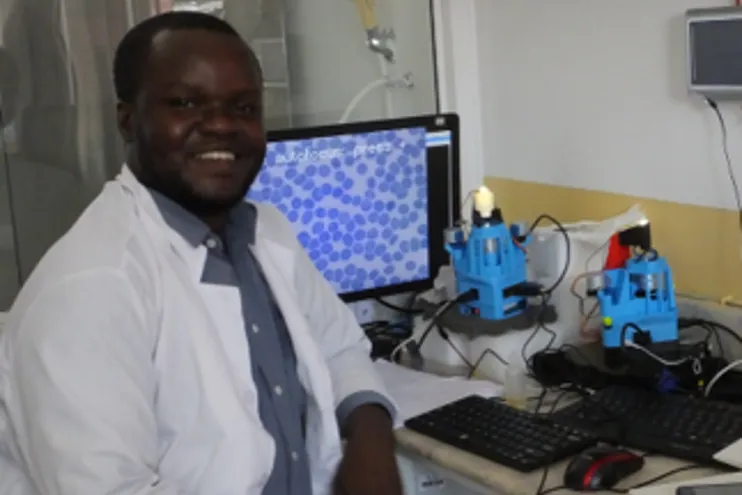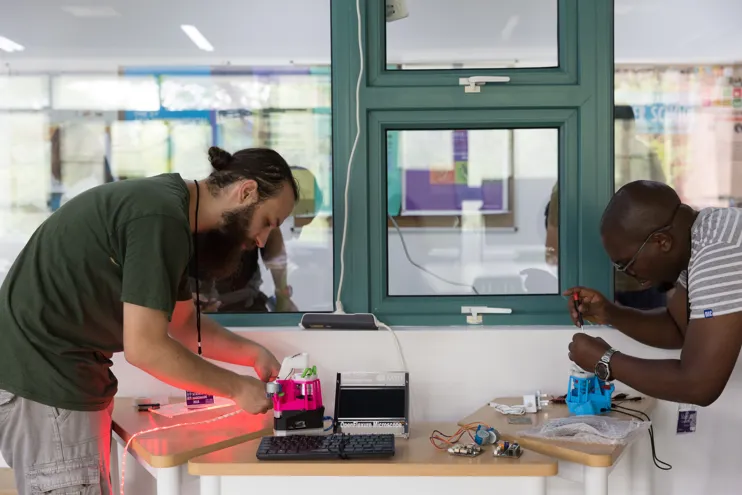Microscopy for everyone: How the OpenFlexure Microscope is changing global healthcare
What links a pathologist in Rwanda, a farmer in Argentina, a teacher in India and a biologist in Antarctica?

Despite these varied backgrounds, they are part of a global community transforming microscopy through open-source collaboration. At the heart of this movement is the OpenFlexure Microscope, an open-source, 3D-printed device that is making high-quality imaging accessible and affordable.
The OpenFlexure Microscope began as a small project, started by Dr Richard Bowman during his time at the University of Cambridge. The innovative flexure-based movement system allows for precise sample positioning without the need for expensive metal components, making the microscope both cost-effective and easily reproducible. While the core OpenFlexure development team are based in Bath and Glasgow, embracing open-source principles has allowed the project to evolve beyond the lab, with engineers, educators, and researchers worldwide contributing to its design and applications.
With a parts cost of under £400, the OpenFlexure Microscope offers a compelling alternative to conventional automated slide scanners, which can cost tens or even hundreds of thousands of pounds. The OpenFlexure Microscope has been built or used in over 60 countries across every continent, and has enabled crucial advancements in healthcare, education, and research, especially in low-resource settings where traditional microscopes are costly or hard to maintain.
A microscope for global health
Accessible, reliable microscopy is critical in medical diagnostics. In countries such as Rwanda and Tanzania, the OpenFlexure Microscope is being used to study diseases like malaria, while also supporting the training of new medical professionals. Unlike conventional microscopes that require costly maintenance and expert servicing, the OpenFlexure design allows for local assembly, repair, and adaptation.
"We’ve had so many people reach out—some planning to use our designs, others already putting them to work in incredible ways.”, explains Dr Joe Knapper, a core developer on the OpenFlexure project. “One of the biggest highlights of open-source projects is seeing the unexpected impact they have. One research group in the Philippines got in touch after they had already published a paper using our microscope to image Tuberculosis! It’s amazing to see our work take on a life of its own. People have built on our designs in ways we never imagined, and we love hearing about all of them."
The microscope’s affordability, adaptability and performance make it a viable alternative to conventional laboratory equipment. While microscopy is the gold standard for diagnosing many diseases, the upfront costs and maintenance requirements often put traditional microscopes out of reach for many communities.
“When we’re trying to image a red blood cell, we need to align the illumination, sample and lenses within a margin of error of 250 nanometres - a quarter of a thousandth of a millimetre,” explains Joe. “There’s plenty of designs for additional sensors to calibrate the positioning, but they all add cost, weight, and - most importantly - are additional parts to source. Instead, we use the camera stream as a sensor to tell us how well our stage is moving, how well we’re aligned, even when we’re focused on the sample.”
The World Health Organisation estimates that only 10 to 30 per cent of donated medical equipment in sub-Saharan Africa ever becomes operational. By contrast, OpenFlexure’s approach enables local engineers to build and maintain their own devices, empowering them to support their own healthcare systems effectively.

Open-source engineering for education and research
“Beyond healthcare, the OpenFlexure Microscope is being used in classrooms and research facilities worldwide,” explains Dr Julian Stirling, a core developer on the project. “In India, teachers use the microscope to engage students in hands-on scientific exploration. One researcher even used it to study microalgae directly on the Antarctic sea-ice.”
In Chile, Paola Larrauri Aguilar uses the OpenFlexure Microscope to investigate the role of invasive beavers in disseminating water- and faecal-borne parasites. Meanwhile in Argentina, Nano Castro and his colleagues at the Open Agroecology Lab use the OpenFlexure Microscope in agricultural outreach programmes, teaching students and farmers about soil microbes and responsible farming practices. By placing powerful imaging tools into local hands, these projects promote sustainable practices and foster scientific curiosity.
The open-source nature of the project means that anyone with access to a 3D printer and basic electronic components can build their own microscope, fostering a culture of innovation and collaboration. Users contribute to the project by developing new features, improving documentation, and sharing their findings with the broader community. This collective effort has led to significant recognition, including endorsements from the World Health Organisation and the Solve initiative of the Massachusetts Institute of Technology (MIT).
"Because everything is open-source, people aren't just using the microscope—they're adapting it for different use cases," Julian adds. "We've seen modifications for fluorescence imaging, and even integration with AI-based image analysis. Some groups are even coupling lasers into their OpenFlexure Microscopes so they can directly probe the inside of computer chips for security research. This kind of collaborative development wouldn't be possible if the project wasn’t open source."

A community-driven future
“The OpenFlexure Project’s tagline, ‘Microscopy for Everyone’, embodies its commitment to inclusivity and accessibility,” explains Beth Probert MIET, an OpenFlexure team member. “By lowering barriers to entry for microscopy, the project is not only advancing scientific research but also empowering communities to take control of their own healthcare and education.”
“We’ve also seen the Microscope used in applications beyond healthcare,” Beth adds. “We’ve had messages asking if the OpenFlexure Microscope can be sent to space, and have seen projects adapting the Microscope’s hardware so it can be used to manipulate lasers to hack computer chips. We love seeing that our project makes microscopy accessible to everyone and anyone, no matter what you’re interested in building.”
The OpenFlexure project has a proven academic record, with dozens of publications from teams around the world. To extend the impact further into healthcare and education, a new approach was needed. This year, OpenFlexure team members founded the Humanitarian Technology Trust, a UK-based charity which aims to improve access to essential technology where it’s needed most.
For more information about the Humanitarian Technology Trust, or for information on how to contribute, visit www.httrust.org
